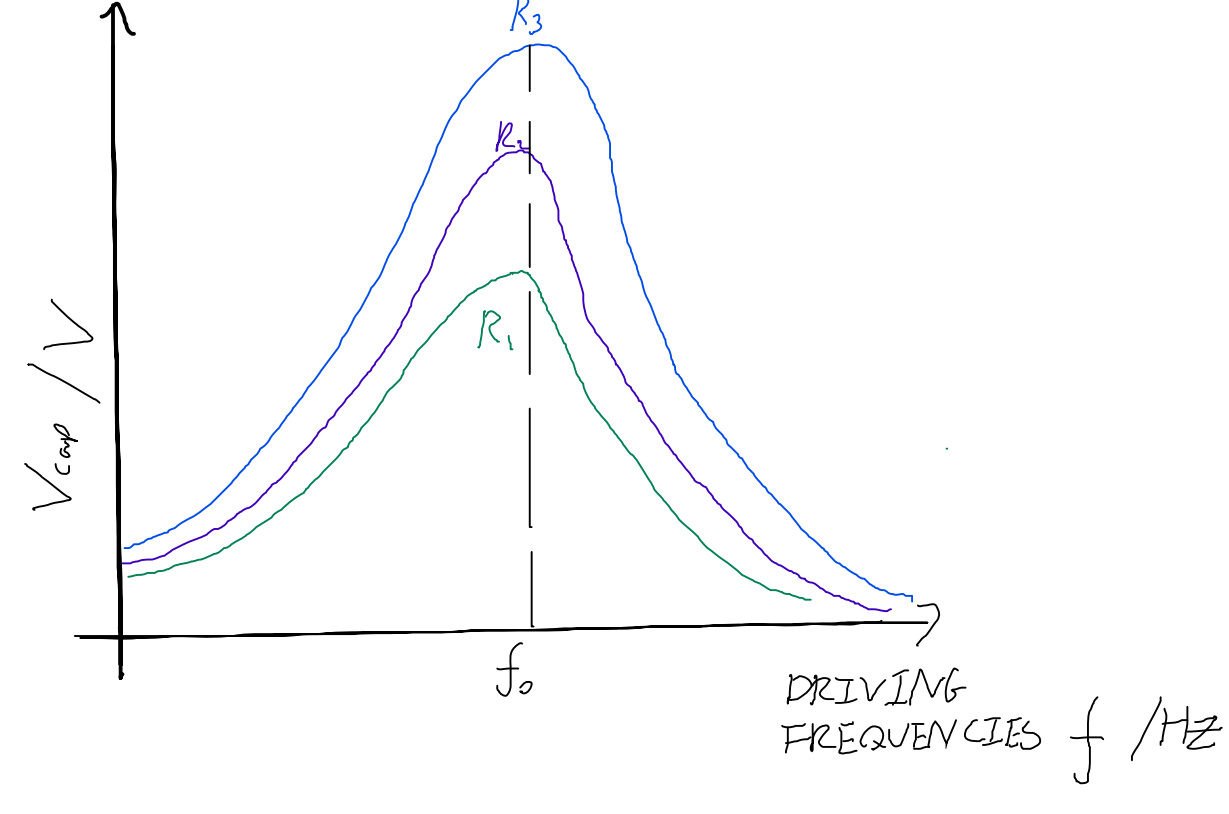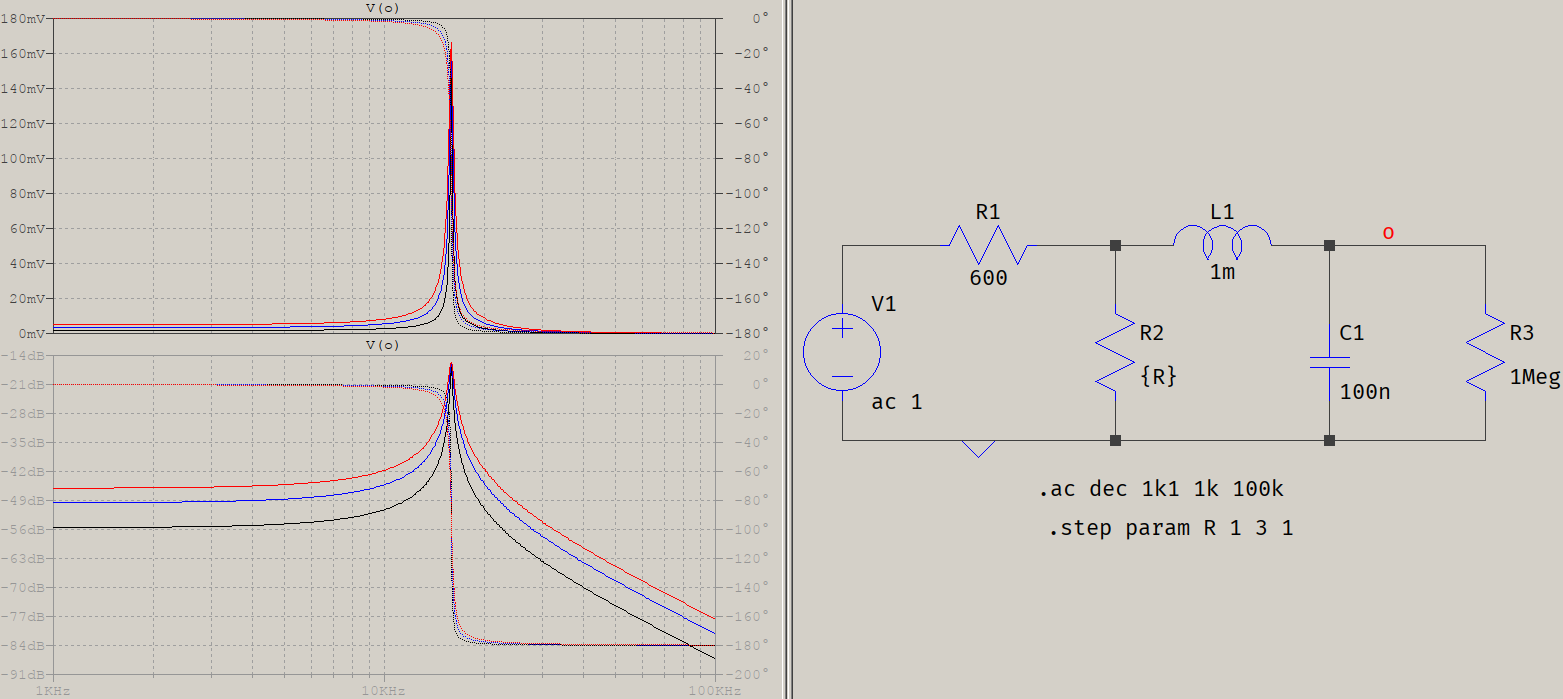First, I will present a method that uses Mathematica to solve this problem. When I was studying this stuff I used the method all the time (without using Mathematica of course). Besides that the answer of @a concerned citizen is excellent.
Well, we are trying to analyze the following circuit:

simulate this circuit – Schematic created using CircuitLab
When we use and apply KCL, we can write the following set of equations:
$$\text{I}_\text{i}=\text{I}_1+\text{I}_2\tag1$$
When we use and apply Ohm's law, we can write the following set of equations:
$$
\begin{cases}
\text{I}_\text{i}=\frac{\text{V}_\text{i}-\text{V}_1}{\text{R}_1}\\
\\
\text{I}_1=\frac{\text{V}_1}{\text{R}_1}\\
\\
\text{I}_2=\frac{\text{V}_1-\text{V}_2}{\text{R}_2}\\
\\
\text{I}_2=\frac{\text{V}_2}{\text{R}_3}
\end{cases}\tag2
$$
Substitute \$(2)\$ into \$(1)\$, in order to get:
$$
\begin{cases}
\frac{\text{V}_\text{i}-\text{V}_1}{\text{R}_1}=\frac{\text{V}_1}{\text{R}_1}+\frac{\text{V}_1-\text{V}_2}{\text{R}_2}\\
\\
\frac{\text{V}_\text{i}-\text{V}_1}{\text{R}_1}=\frac{\text{V}_1}{\text{R}_1}+\frac{\text{V}_2}{\text{R}_3}
\end{cases}\tag3
$$
Now, we can solve for \$\text{V}_2\$:
$$\text{V}_2=\frac{\text{R}_1\text{R}_3\text{V}_\text{i}}{\text{R}_\text{i}\left(\text{R}_2+\text{R}_3\right)+\text{R}_1\left(\text{R}_\text{i}+\text{R}_2+\text{R}_3\right)}\tag4$$
Where I used the following Mathematica-code to find \$(4)\$:
In[1]:=FullSimplify[
Solve[{Ii == I1 + I2, Ii == (Vi - V1)/Ri, I1 == V1/R1,
I2 == (V1 - V2)/R2, I2 == V2/R3}, {Ii, I1, I2, V1, V2}]]
Out[1]={{Ii -> ((R1 + R2 + R3) Vi)/((R2 + R3) Ri + R1 (R2 + R3 + Ri)),
I1 -> ((R2 + R3) Vi)/((R2 + R3) Ri + R1 (R2 + R3 + Ri)),
I2 -> (R1 Vi)/((R2 + R3) Ri + R1 (R2 + R3 + Ri)),
V1 -> (R1 (R2 + R3) Vi)/((R2 + R3) Ri + R1 (R2 + R3 + Ri)),
V2 -> (R1 R3 Vi)/((R2 + R3) Ri + R1 (R2 + R3 + Ri))}}
So, the transfer function is given by:
$$\mathcal{H}:=\frac{\text{V}_2}{\text{V}_\text{i}}=\frac{\text{R}_1\text{R}_3}{\text{R}_\text{i}\left(\text{R}_2+\text{R}_3\right)+\text{R}_1\left(\text{R}_\text{i}+\text{R}_2+\text{R}_3\right)}\tag5$$
Now, applying this to your circuit we need to use (from now on I use the lower case letters for the function in the 'complex' s-domain where I used Laplace transform):
- $$\text{R}_2=\text{sL}\tag6$$
- $$\text{R}_3=\frac{1}{\text{sC}}\tag7$$
So, we can rewrite \$(5)\$:
$$\mathcal{h}\left(\text{s}\right)=\frac{\text{R}_1\cdot\frac{1}{\text{sC}}}{\text{R}_\text{i}\left(\text{sL}+\frac{1}{\text{sC}}\right)+\text{R}_1\left(\text{R}_\text{i}+\text{sL}+\frac{1}{\text{sC}}\right)}=$$
$$\frac{\text{R}_1}{\text{CL}\left(\text{R}_\text{i}+\text{R}_1\right)\text{s}^2+\text{CR}_\text{i}\text{R}_1\text{s}+\text{R}_\text{i}+\text{R}_1}\tag8$$
Using the fact that for sinusoidal voltages we know that \$\text{s}:=\text{j}\omega\$ (where \$\text{j}^2=-1\$ and \$\omega=2\pi\text{f}\$), we can write for the amplitude:
$$\left|\underline{\mathcal{h}}\left(\text{j}\omega\right)\right|=\left|\frac{\text{R}_1}{\text{CL}\left(\text{R}_\text{i}+\text{R}_1\right)\left(\text{j}\omega\right)^2+\text{CR}_\text{i}\text{R}_1\text{j}\omega+\text{R}_\text{i}+\text{R}_1}\right|=$$
$$\frac{\left|\text{R}_1\right|}{\left|\text{R}_\text{i}+\text{R}_1-\text{CL}\left(\text{R}_\text{i}+\text{R}_1\right)\omega^2+\text{CR}_\text{i}\text{R}_1\omega\text{j}\right|}=$$
$$\frac{\text{R}_1}{\sqrt{\left(\text{R}_\text{i}+\text{R}_1-\text{CL}\left(\text{R}_\text{i}+\text{R}_1\right)\omega^2\right)^2+\left(\text{CR}_\text{i}\text{R}_1\omega\right)^2}}\tag9$$
Now, using the fact that \$\text{R}_\text{i}=600\space\Omega\$, \$\text{C}=100\cdot10^{-9}\space\text{F}\$, and \$\text{L}=1\cdot10^{-3}\space\text{H}\$. So we get:
$$\displaystyle\left|\underline{\mathcal{h}}\left(\text{j}\omega\right)\right|=\frac{10^{10}\text{R}_1}{\sqrt{\left(\text{R}_1+600\right)^2\omega^4+2\cdot10^{10}\left(\text{R}_1\left(17\text{R}_1-1200\right)-360000\right)\omega^2+10^{20}\left(\text{R}_1+600\right)^2}}\tag{10}$$
Where I used the following Mathematica-code to find \$(10)\$:
In[2]:=Clear["Global`*"];
x = R1/(R1 + Ri + c R1 Ri s + c L (R1 + Ri) s^2);
s = I*\[Omega];
Ri = 600;
c = 100*10^(-9);
L = 1*10^(-3);
FullSimplify[
Sqrt[(ComplexExpand[Re[x]])^2 + (ComplexExpand[Im[x]])^2],
Assumptions -> R1 > 0 && \[Omega] >= 0]
Out[2]=(10000000000 R1)/Sqrt[
100000000000000000000 (600 + R1)^2 +
20000000000 (-360000 + R1 (-1200 + 17 R1)) \[Omega]^2 + (600 +
R1)^2 \[Omega]^4]
The maximum occurs when (assuming that it must be positive):
$$\omega_0=2\pi\text{f}_0=\frac{100000\sqrt{\text{R}_1\left(1200-17\text{R}_1\right)+360000}}{\text{R}_1+600}\space\Longleftrightarrow\space$$
$$\text{f}_0=\frac{100000\sqrt{\text{R}_1\left(1200-17\text{R}_1\right)+360000}}{2\pi\left(\text{R}_1+600\right)}=\frac{50000\sqrt{\text{R}_1\left(1200-17\text{R}_1\right)+360000}}{\pi\left(\text{R}_1+600\right)}\tag{11}$$
Where I used the following Mathematica-code to find \$(11)\$:
In[3]:=FullSimplify[
Solve[{D[%2, \[Omega]] == 0, R1 > 0 && \[Omega] >= 0}, \[Omega]]]
Out[3]={{\[Omega] ->
ConditionalExpression[0,
0 < R1 < 600/17 (1 + 3 Sqrt[2]) ||
R1 > 600/17 (1 + 3 Sqrt[2])]}, {\[Omega] ->
ConditionalExpression[(100000 Sqrt[360000 + (1200 - 17 R1) R1])/(
600 + R1), 0 < R1 < 600/17 (1 + 3 Sqrt[2])]}}






